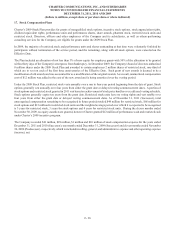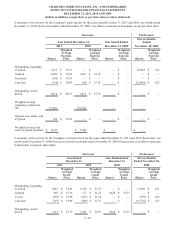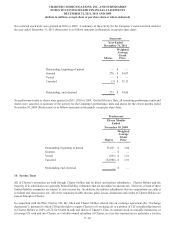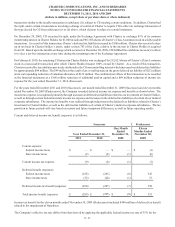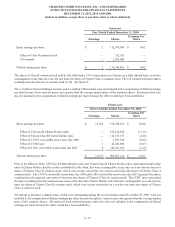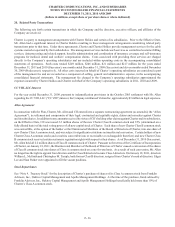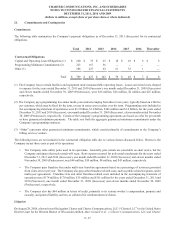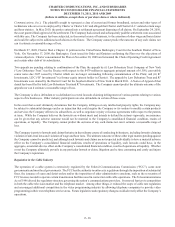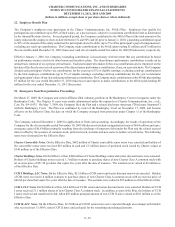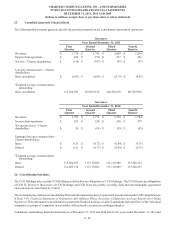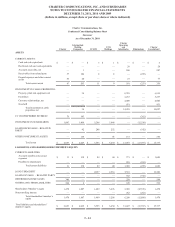Charter 2011 Annual Report Download - page 122
Download and view the complete annual report
Please find page 122 of the 2011 Charter annual report below. You can navigate through the pages in the report by either clicking on the pages listed below, or by using the keyword search tool below to find specific information within the annual report.
CHARTER COMMUNICATIONS, INC. AND SUBSIDIARIES
NOTES TO CONSOLIDATED FINANCIAL STATEMENTS
DECEMBER 31, 2011, 2010 AND 2009
(dollars in millions, except share or per share data or where indicated)
F- 38
Communications, Inc.). The plaintiffs sought to represent a class of current and former broadband, system and other types of
technicians who are or were employed by Charter or Charter LLC and alleged that Charter and Charter LLC violated certain wage
and hour statutes. In May 2010, the parties entered into a settlement agreement disposing of all claims. On September 24, 2010,
the court granted final approval of the settlement. The Company had accrued and subsequently paid the settlement costs associated
with this case. The Company has been subjected, in the normal course of business, to the assertion of other wage and hour claims
and could be subjected to additional such claims in the future. The Company cannot predict the outcome of any such claims nor
can it estimate a reasonable range of loss.
On March 27, 2009, Charter filed a Chapter 11 petition in the United States Bankruptcy Court for the Southern District of New
York. On November 17, 2009, the Bankruptcy Court issued its Order and Opinion confirming the Plan over the objections of
various objectors. Charter consummated the Plan on November 30, 2009 and reinstated the Charter Operating Credit Agreement
and certain other debt of its subsidiaries.
Two appeals are pending relating to confirmation of the Plan, the appeals by (i) Law Debenture Trust Company of New York
(“Law Debenture Trust”) (as the Trustee with respect to the $479 million in aggregate principal amount of 6.50% convertible
senior notes due 2027 issued by Charter which are no longer outstanding following consummation of the Plan); and (ii) R2
Investments, LDC (“R2 Investments”) (a former equity interest holder in Charter). The appeals by Law Debenture Trust and R2
Investments were denied by the District Court for the Southern District of New York in March 2011. A Notice of Appeal of that
denial has been filed by both Law Debenture Trust and R2 Investments. The Company cannot predict the ultimate outcome of the
appeals nor can it estimate a reasonable range of loss.
The Company is also a defendant or co-defendant in several lawsuits claiming infringement of various patents relating to various
aspects of its businesses. Other industry participants are also defendants in certain of these cases.
In the event that a court ultimately determines that the Company infringes on any intellectual property rights, the Company may
be subject to substantial damages and/or an injunction that could require the Company or its vendors to modify certain products
and services the Company offers to its subscribers, as well as negotiate royalty or license agreements with respect to the patents
at issue. While the Company believes the lawsuits are without merit and intends to defend the actions vigorously, no assurance
can be given that any adverse outcome would not be material to the Company's consolidated financial condition, results of
operations, or liquidity. The Company cannot predict the outcome of any such claims nor can it estimate a reasonable range of
loss.
The Company is party to lawsuits and claims that arise in the ordinary course of conducting its business, including lawsuits claiming
violation of anti-trust laws and violation of wage and hour laws. The ultimate outcome of these other legal matters pending against
the Company cannot be predicted, and although such lawsuits and claims are not expected individually to have a material adverse
effect on the Company’s consolidated financial condition, results of operations or liquidity, such lawsuits could have, in the
aggregate, a material adverse effect on the Company’s consolidated financial condition, results of operations or liquidity. Whether
or not the Company ultimately prevails in any particular lawsuit or claim, litigation can be time consuming and costly and injure
the Company's reputation.
Regulation in the Cable Industry
The operation of a cable system is extensively regulated by the Federal Communications Commission (“FCC”), some state
governments and most local governments. The FCC has the authority to enforce its regulations through the imposition of substantial
fines, the issuance of cease and desist orders and/or the imposition of other administrative sanctions, such as the revocation of
FCC licenses needed to operate certain transmission facilities used in connection with cable operations. The Telecommunications
Act of 1996 altered the regulatory structure governing the nation’s communications providers. It removed barriers to competition
in both the cable television market and the telephone market. Among other things, it reduced the scope of cable rate regulation
and encouraged additional competition in the video programming industry by allowing telephone companies to provide video
programming in their own telephone service areas. Future legislative and regulatory changes could adversely affect the Company’s
operations.


